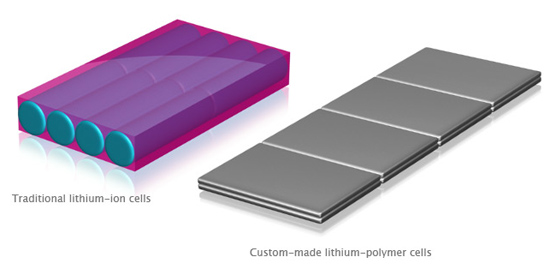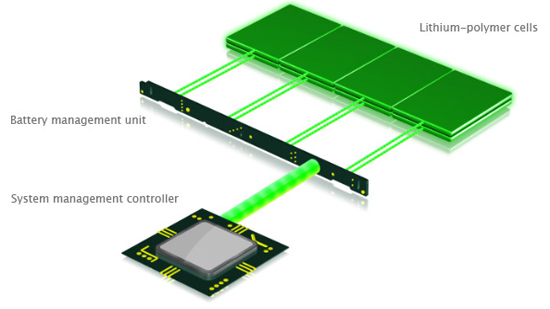Apple's 2009 MacBook Pro: Battery Life to Die For
by Anand Lal Shimpi on June 12, 2009 12:00 AM EST- Posted in
- Mac
I was so focused on the iPhone 3GS and Snow Leopard announcements from this year’s WWDC that I almost missed the gravity of the MacBook Pro announcements.
Apple announced price drops on nearly all of its laptops. The new lineup looks like this:
| MacBook | MacBook Pro 13-inch | MacBook Pro 15-inch | MacBook Pro 17-inch | |
| CPU | Core 2 Duo 2.13GHz | Core 2 Duo 2.26GHz | Core 2 Duo 2.53GHz | Core 2 Duo 2.8GHz |
| GPU | NVIDIA GeForce 9400M | NVIDIA GeForce 9400M | NVIDIA GeForce 9400M | NVIDIA GeForce 9400M + 9600M |
| Memory | 2GB DDR2 | 2GB DDR3 | 4GB DDR3 | 4GB DDR3 |
| HDD | 160GB | 160GB | 250GB | 500GB |
| Battery Life | Up to 5 hours | Up to 7 hours | Up to 7 hours | Up to 8 hours |
| Price | $999 | $1199 | $1699 | $2499 |
If you want an all aluminum body, you have to buy a MacBook Pro. There’s only a single MacBook model and it’s the white chassis that’s been around for a while now.
Apple added a 13” MacBook Pro to the lineup to fill in the gap, although it’s not clear to me whether this 13” MacBook Pro uses the same LCD panel as the old 13” aluminum MacBook or a derivative of the 15” MacBook Pro’s panel, which is superior.
 Of course there are different models within each one of these categories that you can purchase, but they are irrelevant to the discussion we’re about to have. Look at the battery life row in the table above; Apple is claiming up to 7 hours of battery on the new MacBook Pros. The old specs used to be up to 5 hours.
Of course there are different models within each one of these categories that you can purchase, but they are irrelevant to the discussion we’re about to have. Look at the battery life row in the table above; Apple is claiming up to 7 hours of battery on the new MacBook Pros. The old specs used to be up to 5 hours.
Apple did some clever work on its own here. Standard lithium ion batteries are made up of cylindrical cells, similar to AA batteries. The problem with these batteries is that they waste a lot of space within a notebook (try cramming a lot of cylinders into a box, you end up with wasted space). This wasted space translates into larger batteries than are necessary, which makes for larger notebooks.
In order to continue to drive laptop thinness down, Apple started experimenting with using custom lithium polymer batteries instead of the industry standard lithium ion parts. Lithium polymer cells aren’t made of cylindrical cells (they’re rectangular), so there’s no wasted space. Not only does this make the batteries more compact, but it also gives you greater capacity since you’re using all available chassis volume for the battery.

Makes sense. Courtesy, Apple.
Apple also found that it was wasting space in the removable enclosure for the batteries as well, so its lithium polymer offerings are no longer user removable. I suspect this part of the equation has more to do with cutting costs than saving space though.
Apple first used this lithium polymer battery technology in its MacBook Air. It gave Apple a very thin battery that allowed it to create the MacBook Air’s sweet form factor. Then came the new 17” MacBook Pro, without a removable battery. Apple claimed that this battery would last for five years before it needed replacing and resulted in up to an 8 hour battery life.

The extended life is supposedly due to an on-battery sensor that communicates with the system's management controller that can dynamically sense the needs of each lithium polymer cell and feed that info back to the charging circuitry. The result is slight variations in charging current designed to optimally charge each and every cell; apparently reducing wasted charge cycles significantly. Apple claims that most cells will hit 80% of their life after 200 - 300 charge cycles, but its special lithium polymer batteries will hit the 80% mark after as many as 1000 charge cycles. Apple claims its unique battery chemistry and microprocessor managed charging (Adaptive Charging) is responsible for these gains but it’s a difficult statement to prove; we’ll have to wait and see what happens after a few years of use.










113 Comments
View All Comments
JimmiG - Friday, June 12, 2009 - link
Yeah, a few quick battery tests under Windows would be nice. From what I've read, Macbooks only have excellent battery life under OSX. Under Windows, they are like any other PC with a 50 - 90whr battery.Sadly this seems to be one aspect Microsoft won't "fix" with Windows7 - although I guess it's mostly the fault of hardware manufacturers releasing poorly optimized drivers and firmwares...
solipsism - Friday, June 12, 2009 - link
• The 13” MBP has a screen that is now equivalent to the 13” MBA. The change apparently happened a month or two ago, silently. People on some Apple-based forums were reporting that their new MB had a screen like their MBA/MBP or that it was unlike their previous MB. This is one reason that the rumour of the MB going Pro was likely.• The 60W power supply is indeed for the low-end 15” MBP with 9400M. Apple’s MBP tech specs list both for their 15” mode: "60W or 85W MagSafe Power Adapter with cable management system"
aliasfox - Friday, June 12, 2009 - link
I haven't confirmed this, but at WWDC it was announced that the new 15" has 60% better color gamut than the old one, and that the new 13" MBP matches the new 15" screen. A 60% increase in color gamut suggests a move to RGB LED, same as the nice top end Dell and Acer screens that Anandtech reviewed a couple of months ago. The other reason the MBP is now "Pro" could be the re-inclusion of Firewire. Yay!iwodo - Friday, June 12, 2009 - link
If, and only IF, they are using RGB LED ( which i highly doubt it, honestly )Then Macbook Pro would be a Bargain to buy for its price.
I also wonder why they aren't advertising RGB LED if they are indeed using it.
The only reason i think the increase of 60% Gamut may be of Better Panel. However i also know there are no Panel Tech that could increase Gamut by 60%...
Anybody shine some light on this?
PlasmaBomb - Saturday, June 13, 2009 - link
A site that reviews notebooks mentions the +60% Gamut, but doesn't mention RGB LED that I can see. Although the review is still ongoing.santala - Friday, June 12, 2009 - link
I recently took apart an old Macbook white battery and it was already using these thin cells and not the traditional round ones. The battery was dead and at least a year old, more likely two or three, perhaps as old as the first Intel Macbooks.So the story about "new" technology is simply not true. I would argue that Macbooks have always used these thin battery cells, they're just able to cram more of them (or bigger ones) into the things once they don't have to worry about the part about the being removable.
santala - Friday, June 12, 2009 - link
And obviously the old ones were Li-Ion.PlasmaBomb - Friday, June 12, 2009 - link
You are confusing a rectangular battery with rectangular cells.I presume your battery looks like this -
http://pics.bbzzdd.com/users/PlasmaBomb/Mid_2006.J...">http://pics.bbzzdd.com/users/PlasmaBomb/Mid_2006.J...
Which is indeed a rectangular lithium ion pack. It will however contain cylindrical cells. Also lithium ion != lithium polymer.
RikkiTikkiTavi - Friday, June 12, 2009 - link
Apple simply got their facts wrong here. Lithium ion batteries can be made in cylindrical forms, but are usually flat.Scientific explanation (from yours truly, an aerospace engineer with some, limited experience on the matter):
Conventional batteries (that is everything up to and including Ni-MH cells) work by dissolving metal in a solution, and then restoring it to recharge. While lithium has excellent properties to store energy, recharging wouldn't work, for reasons I will not elaborate upon here (ask if you really want to know).
So instead of forming a lithium metal grid, in the recharged state the lithium ions are stored in a different medium, often a porous Graphite grid.
Graphite is most easily cut into slim slices, and looses a lot of its ion-storing capacity when forced into a cylindrical form.
Even if you don't use Graphite, you still have the problem, that, in order to achieve sufficient power density to supply a laptop, you have to expand the working surface of your battery by forming layers. These have to be of equal capacity, or else the power density would drop before the unit is completely discharged. No problem with flat layers, but in a cylindrical cell, you'd have to make the inner layers thicker and the outer layers thinner, to keep the capacity constant, which creates numerous problems.
Yes, cylindrical Li-ion cells exist, but no, they are not common.
ncbill - Saturday, June 13, 2009 - link
Many popular li-ion cells are cylindrical.The 18500 Li-Ion cylindrical cell is very common and widely used.
For anything from laptop batteries to the Tesla Roadster.